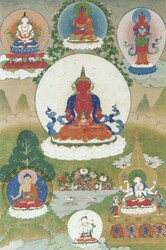
Subject: Appropriation, Painting Pastiche #1
Appropriation, Painting Pastiche #1 | Contemporary Art: AppropriationThe image of the painting at the right is a modern appropriation (21st century) of the other three paintings situated at the right and left sides below.
The painting on the left, a seated White Chakrasamvara 18th century, is in a Palpung Monastery style employing minimalist landscape and 17-18th century Khyenri style iconographic figures. The painting on the right side, a white standing Chakrasamvara, also 18th century, is done in a Tashi Lhunpo Monastery painting style following the earlier and much acclaimed New Menri style of Choying Gyatso.
The standing White Chakrasamvara painting is copying the two styles of figures from the paintings on the left and right sides. The central larger figure is borrowed from the right side painting and five of the secondary figures from the left side painting. The top middle figure of of the standing White Chakrasamvara painting is Amitayus and borrowed from a third painting (HAR #12159). The landscape background is further borrowed from the Beijing/Chengde painting style evidenced by symmetrical clouds, balanced alternating colours, and mountain features with melting characteristics.
So, in conclusion, with regard to the central painting, while we can say that the figures depicted do individually have iconographic integrity, the mixing of the two iconographic styles and the placement of the figures on a Qianlong Emperor period Chinese landscape background, renders the painting primarily decorative and not properly traditional or orthodox.
Key Points:
- A mixture of three different painting styles
- Two iconographic figure painting styles
- Primary and secondary figures not textually or stylistically related
- Painting on the left: Karma Kagyu Tradition
- Painting on the right: Gelug Tradition
Skill level of the artist: Good.
Jeff Watt 6-2017 [updated 11-2018]



